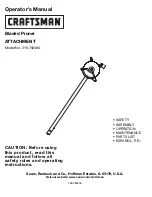
9
Work Piece and Work Area Set Up
1. Designate a work area that is clean and well-lit. The work area must not allow access by
children or pets to prevent distraction and injury.
2. Route the air hose along a safe route to reach the work area without creating a tripping
hazard or exposing the air hose to possible damage. The air hose must be long enough to
reach the work area with enough extra length to allow free movement while working.
3. Secure loose workpieces using a vise or clamps (not included) to prevent movement while
working.
4. There must not be hazardous objects (such as utility lines or foreign objects) nearby that will
present a hazard while working.
General Operating Instructions
This Saw may be used for cutting through copper, sheet metal, aluminum, and plastic.
When cutting sheet metal, the angled face of the Blade Guard should rest on the plate to
Minimize its chatter, allowing for smoother cutting action.
WARNING! Do not exceed the maximum 16 gauge thickness when cutting sheet metal
with this Saw.
Doing so can cause serious injury and damage to the tool.
WARNING:
Do not use a dull or cracked blade. Check that the blade and Blade Guard are
secured tightly before every use.
Operate the Saw with two hands. Hold the Housing and throttle with one hand, keeping your
forefinger behind the Safety Catch. Hold the front end of the tool with your other hand. Keep all
fingers behind the handle recess but do not cover the Chuck vent holes.
WARNING!
Failure to use two hands may cause the Saw to vibrate out of your control causing
serious injury.
1. Once the blade is securely installed, push the Safety Catch forward to release the Throttle.
Then press down on the Throttle to activate the Saw.
2. Contact the workpiece allowing the Saw to do the cutting for you. Do not exert excessive
pressure on the workpiece.
NOTE:
If the tool requires more force to accomplish the task, verify that the tool receives
sufficient, unobstructed airflow (CFM) and increase the pressure (PSI) output of the regulator
up to the maximum air pressure rating of this tool. If the tool still does not have sufficient force
at maximum pressure and sufficient airflow, then a larger tool may be required.
3. To prevent accidents, turn off the tool, detach the air supply, safely discharge any residual air
pressure in the tool, and release the throttle and/or turn the switch to its off position after use.
Clean external surfaces of the tool with a clean, dry cloth. Then store the tool indoors out of
children’s reach.
WARNING!
To prevent tool and accessory failure, resulting in injury, do not exceed the
tool’s maximum air pressure rating.
Summary of Contents for CT1406
Page 2: ...1...
Page 13: ...12 ASSEMBLY DIAGRAM AND PARTS LIST...
Page 14: ...13...
Page 15: ...14...
Page 16: ...15 CANNON TOOLS LTD Add 20 station road Rowley Regis west midlands B65 0JU U K Made in China...


































